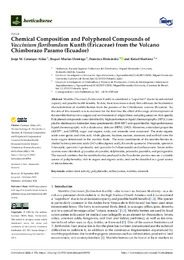Please use this identifier to cite or link to this item:
https://hdl.handle.net/11000/34299Full metadata record
| DC Field | Value | Language |
|---|---|---|
| dc.contributor.author | Caranqui, Jorge | - |
| dc.contributor.author | Muelas, Raquel | - |
| dc.contributor.author | Hernández, Francisca | - |
| dc.contributor.author | Martínez Font, Rafael | - |
| dc.contributor.other | Departamentos de la UMH::Producción Vegetal y Microbiología | es_ES |
| dc.date.accessioned | 2025-01-10T19:12:59Z | - |
| dc.date.available | 2025-01-10T19:12:59Z | - |
| dc.date.created | 2022-10-16 | - |
| dc.identifier.citation | Horticulturae 2022, 8(10), 956 | es_ES |
| dc.identifier.issn | 2311-7524 | - |
| dc.identifier.uri | https://hdl.handle.net/11000/34299 | - |
| dc.description.abstract | Mortiño (Vaccinium floribundum Kunth) is considered a “superfruit” due to its antioxidant capacity and possible health benefits. To date, there is no known study that addresses the biochemical characterization of mortiño berries from the paramo of the Chimborazo volcano (Ecuador). So, the aim of this research was to evaluate for the first time the effect of the stage of development of the mortiño berries (two stages) and environment of origin (three sampling areas) on fruit quality. Polyphenol compounds were identified by high-performance liquid chromatography (HPLC) coupled to electrospray ionization mass spectrometric (ESI-MSn) and quantified by high-performance liquid chromatography with a diode array detector (HPLC-DAD). Moreover, antioxidant properties (ABTS•+, and DPPH), sugar and organic acids, and minerals were examined. The main organic acids were quinic and citric acid, while glucose, fructose, sucrose, mannose, and sorbitol were the main sugars determined in the mortiño fruits. The main constituents of the mortiño berries included hydroxycinnamic acids (5-O-caffeoylquinic acid), flavonols (quercetin 3-hexoside, quercetin 5-hexoside, quercetin 3-pentoside, and quercetin-3-O-rhamnoside) and anthocyanins. Seven anthocyanins were identified: glycosides of cyanidin, delphinidin, petunidin, peonidin, and pelargonidin. The research confirms that the mortiño berries produced in the Ecuadorian paramo area are a valuable source of polyphenolics, rich in sugars and organic acids, and can be classified as a good source of microelements | es_ES |
| dc.format | application/pdf | es_ES |
| dc.format.extent | 18 | es_ES |
| dc.language.iso | eng | es_ES |
| dc.publisher | MDPI | es_ES |
| dc.rights | info:eu-repo/semantics/openAccess | es_ES |
| dc.rights | Attribution-NonCommercial-NoDerivatives 4.0 Internacional | * |
| dc.rights.uri | http://creativecommons.org/licenses/by-nc-nd/4.0/ | * |
| dc.subject | Antioxidant activity | es_ES |
| dc.subject | Polyphenolic | es_ES |
| dc.subject | Anthocyanins | es_ES |
| dc.subject | Mortiño | es_ES |
| dc.subject | Minerals | es_ES |
| dc.title | Chemical Composition and Polyphenol Compounds of Vaccinium floribundum Kunth (Ericaceae) from the Volcano Chimborazo Paramo (Ecuador) | es_ES |
| dc.type | info:eu-repo/semantics/article | es_ES |
| dc.relation.publisherversion | https://doi.org/10.3390/horticulturae8100956 | es_ES |

View/Open:
Chemical Composition and Polyphenol Compounds of Vaccinium floribundum Kunth.pdf
835,19 kB
Adobe PDF
Share:
.png)
